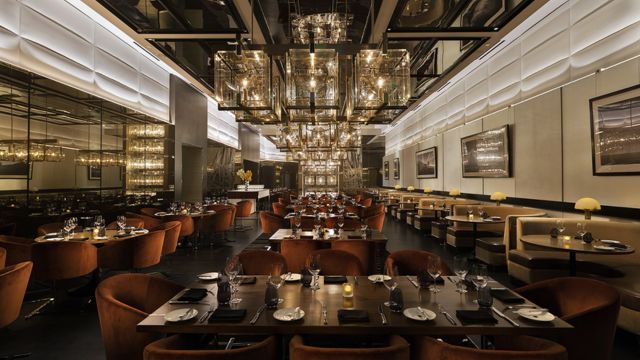
The United States has a rich and diverse culinary history, which is reflected in its restaurants. America’s iconic restaurants have developed to meet the evolving tastes of the nation, from humble beginnings in the 18th century to the present eating scene. Classic restaurants in America retain a distinct place in the country’s culinary scene, providing not just wonderful food but also a look into the past.
Many of these institutions have developed to match changing preferences and expectations of generations while retaining their particular charm and authenticity. The growth of America’s legendary eateries is a journey through history, community, and culinary excellence, from renowned delis to timeless diners.
The Early Years
The early restaurants in America served modest fare such as stews, soups, and roasted meats. Travelers, merchants, and other members of the working class frequented these early eateries, which were sometimes housed in taverns or coffeehouses.
As America’s cities increased in the early nineteenth century, so did the desire for more refined dining options. Fine-dining establishments began to spring up in major cities such as New York, Philadelphia, and Boston. These restaurants featured French-inspired cuisine and quickly gained popularity among the wealthy and elite.

Preserving Tradition Amidst Change
Walking inside Katz’s Delicatessen, Kossar’s Bagels & Bialys, or Wo Hop in Manhattan’s Lower East Side transports guests to a period where the décor, cuisine, and ambiance have remained largely untouched since the early twentieth century.
These old enterprises, including the Berghoff in Chicago, the Pine Club in Dayton, Ohio, the Arcade Restaurant in Memphis, and the White Horse Tavern in Newport, Rhode Island, have become emblems of constancy in an ever-changing world. These classic restaurants provide more than simply a meal; they take you on a journey through history and culture.
The notion of a traditional restaurant, however, is not limited to its age. Classics are also evolving at restaurants such as Ipanema in Manhattan, Genghis Cohen in Los Angeles, and Gott’s Roadside in Northern California. These restaurants have adapted by modifying their menus and décor while retaining their essential spirit. Their growth demonstrates their capacity to embrace innovation while maintaining the ideals that made them classics in the first place.
The Essence of Classic Restaurants
What distinguishes a classic restaurant from an ordinary old one? According to Kysha Harris, a member of the James Beard Foundation’s Restaurant and Chef Awards Committee, what makes a classic is a commitment to serve the community via excellent food, hospitality, and an enduring legacy. Classic restaurants are more than just places to eat; they are essential components of their communities, providing comfort and familiarity to generations of customers.
Consistency is also important in establishing a restaurant as a classic. Classics are restaurants that have maintained a continuous level of quality, whether in their cuisine or ambiance. For example, Lou Mitchell’s, a historic diner in Chicago that has been serving customers for a century, takes pleasure in preserving its quality and standard over the years.
Similarly, The Berghoff in Chicago has left a lasting impression on its customers by creating an experience that goes beyond the act of dining.
Another way to achieve classic status is to avoid trends and focus on ageless design, ambience, and ambiance. Chris Himmel, owner of Harvest in Cambridge, Massachusetts, feels that rather than chasing transient trends, a traditional restaurant should be designed with an enduring design. This attitude ensures that the restaurant is relevant and appealing to people of all ages.
Culinary Legacy and Innovation
Classic restaurants frequently leave an enduring imprint on the culinary world, with some even becoming famous for crafting classic dishes. In the 1920s, the Brown Hotel in Louisville, for example, debuted the Hot Brown sandwich, which has since become a famous regional specialty. Such delicacies add to the restaurant’s tradition and cement its standing as a classic.
Historical publications such as Paul Freedman’s “Ten Restaurants That Changed America” provide additional insight into the growth of America’s dining scene. This book digs into the history of ten notable American restaurants and their long-term impact on the country’s culinary landscape.
Another noteworthy read is “The Thousand Dollar Dinner” by Becky Libourel Diamond, which describes a magnificent banqueting contest between two restaurants that marks a watershed moment in American culinary history.
The Future of America’s Classic Restaurants
It is certain that America’s legendary restaurants will continue to adapt as the twenty-first century progresses. New trends will arise, and restaurants’ menus will continue to evolve. One thing is certain: these restaurants will forever be a part of the American culinary landscape. They serve as a reminder of the country’s rich and diverse culinary heritage, and they continue to provide diners with a taste of American cuisine’s past, present, and future.
Conclusion
The history of America’s legendary restaurants is a story about tenacity, community, and culinary skill. These ageless establishments have adapted to changing times while maintaining their basic beliefs and traditions. Classic restaurants continue to captivate clients and deliver a flavor of history with each visit, whether via constancy, community engagement, or culinary innovation.
As these restaurants evolve, they demonstrate that the true essence of a classic rests not only in its age, but also in its capacity to withstand the test of time while remaining relevant and beloved by successive generations.



